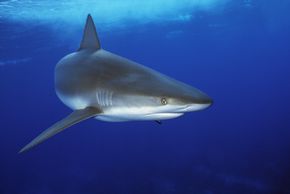Shark Movement
Most bony fish have a special swim bladder that helps them move around in the water. When the fish takes in oxygen, it can release some of the gas into the bladder. This increases the fish's buoyancy, so it rises through the water. To sink down to the bottom, the fish squeezes some of the gas out of the bladder, decreasing its buoyancy. In this way, a fish is something like a blimp or hot air balloon that uses the upward lift of atmospheric buoyancy to change altitude.
A shark is more like an airplane. It doesn't have a swim bladder, so it uses its forward movement to control vertical position. The tail is like the shark's propeller -- the shark swings it back and forth to move forward. In an airplane, this forward movement pushes air around the wings. In a shark, this forward movement pushes water around the fins. In both cases, this movement of matter creates lift -- the fluid is different, but the principle is exactly the same.
Advertisement
Sharks have two sets of paired fins on the sides of their body, in the same general position as the main wings and horizontal tail wings of a plane. The shark can position these fins at different angles, changing the path of the water moving around them. When the shark tilts a fin up, the water flows so there is greater pressure below the fin than above it. This creates upward lift. When the shark tilts the fin down, there is greater pressure above the fin than below it. This pushes the shark downward.
The shark also has one or two vertical dorsal fins on its back and sometimes a vertical anal fin on its underside. These fins work like the vertical stabilizer wing on an airplane. They help the shark keep its balance as it moves through the water and they can be moved from side to side to turn the shark left and right.
This fin arrangement gives sharks amazing maneuverability. They can cruise at high speeds, stop suddenly and make sharp turns in every direction. This is one of the reasons they are such effective hunters. They move more quickly and with greater control than any of their prey -- most of the time, a shark's prey doesn't even know what hit it.
Of course, before a shark can swoop in for the kill, it has to locate its prey. In the next couple sections, we'll examine the finely tuned senses that help sharks locate and track their food.
